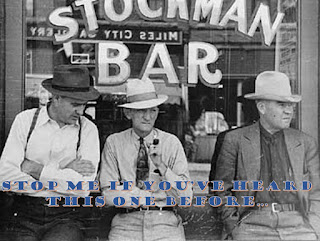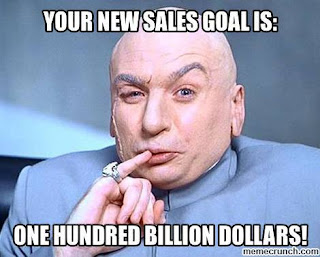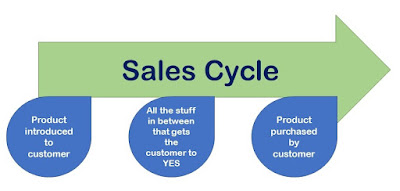Explaining Sales to the New Executive
An Irishman, a Cowboy and a Salesman walked into a bar…
 Remember those jokes from days gone by? It’s been a long time since salespeople needed to have a couple of good jokes up their sleeves. And for some reason, I could never remember the punch lines. Thankfully, the world changed and jokes soon fell out of favor with customers and sellers alike and my career didn’t suffer. But, sometimes life mimics old jokes.
Remember those jokes from days gone by? It’s been a long time since salespeople needed to have a couple of good jokes up their sleeves. And for some reason, I could never remember the punch lines. Thankfully, the world changed and jokes soon fell out of favor with customers and sellers alike and my career didn’t suffer. But, sometimes life mimics old jokes.
Recently, I ran into a business executive in a local bar. During the ensuing conversation, she shared her situation. After years of climbing the corporate ladder and being groomed for bigger and better things, she finds herself in charge of her company’s sales effort. Congratulations to her, but there was a problem. She had no previous sales experience, no real exposure to the selling in any form and was struggling to understand how to make a difference in her new department.
I quipped that I work with sales groups throughout the country. Her eyes lit up and she asked me to give her the lowdown on sales. To sweeten the pot, she bought me a beer. How could I say no?
In the next four minutes, allow me to share my explanation.
Selling isn’t what you probably expect…
Common wisdom paints selling as a sleazy business where
customers are tricked, cajoled or somehow bribed into making a purchase. With the possible exception of timeshare tours and used cars, this applies to every form of selling. This is especially true in B2B sales, which is precisely where she lives. Instead, selling is about skillsets and orchestrated team play. For distributors, the team play revolves around specialists, inside salespeople, application engineers and even sales management.
Since selling is about skillsets, we can assume that
salespeople are developed and not, as common wisdom sometimes dictates, born. During my forty year tenure in sales and sales management, I have seen successful sellers with all kinds of personality types; introverts, extroverts, techno-geeks and many more. The differentiating fact between the best and average typically boils down to work ethic, skills and process. Further, as one VP of Sales shared, “In today’s team selling environment, I won’t hire a cowboy superstar. We have worked hard to develop a team, and there’s no place for prima-donna behavior on our team.”
Since sales skills are important, one would expect sales organizations to constantly reinforce the right skills. At the same time, real sales skills are rarely taught. I told her to review the agendas of the last few team sales meetings. Did sales methods and sales skill refreshers even make the list? This is an epidemic issue across the entire sales industry. Sales meeting have digressed to technology reviews, community bulletin boards and product trivia. Skills need constant refreshers, coaching and review.
 Sales people work without a great deal of oversight. In most organizations, sales managers rarely make customer calls with their team; with two or three times a year being the norm. Because there is little time/opportunity to gauge skills in action, there is a need for mid-stream measures of success which look into the progress. Most sales managers focus on sales totals rather than the actions which drive sales. This is a mistake.
Sales people work without a great deal of oversight. In most organizations, sales managers rarely make customer calls with their team; with two or three times a year being the norm. Because there is little time/opportunity to gauge skills in action, there is a need for mid-stream measures of success which look into the progress. Most sales managers focus on sales totals rather than the actions which drive sales. This is a mistake.
Sales is about determining the right customers…
Most sales organizations have more “prospects” than they can handle. Many invest mass quantities of resources chasing down customers who probably won’t turn out to be profitable customers. Companies who spend the time to identify the right best potential customer and focusing efforts on these “targets” are 47 percent more likely to meet their sales goals than those who blindly chase every lead possible.
Many times the right customers are already doing some business with your company. Sales experts, armed with research data, indicate it is five times easier to sell more to an existing customer than to pursue and open a new account. The point is to evaluate existing customers for new opportunities and missed sales. In the world of distribution, this is called a gap analysis. (I have an example, I would share for the asking.)
Sale is ultimately about driving profitable sales…
Don’t confuse gross margin or sales volume with profitability. Based on analysis of most organizations’ sales, the cost to service many of your accounts is higher than the gross margin generated by the account. This takes into consideration things like technical support, order size, amount of handling and the overall hassle factors associated with dealing with the customer.
By the way, this topic is heresy within most sales organizations. The prevailing attitude is every sale is a good sale and every customer an important cog in the wheel. While this model may work for establishments like Amazon where there are no sales professionals, for the majority of selling organizations, the need to understand this profitability thing is high.
The more you understand your sales cycle, the better…
I have seen company presidents hire new salespeople and begin budgeting for increased numbers within months of the new salesperson’s arrival. For the most part, everybody is disappointed and here’s why. It’s called the sales cycle.
 The sales cycle is the time line from the introduction to the purchase of a product. In many instances, the sales cycle is longer than most believe. For example, if you are selling components which will be incorporated into an original equipment maker’s (OEM) product, the sales cycle includes OEM’s design and engineering time. There may be testing, trials and other aspects in the evaluation. Further, many OEMs only change their designs every few years. The sales cycle is long. For End Users of products the sales cycle can be shorter. Keeping this in mind, let’s look at the error made by the previously mentioned company president.
The sales cycle is the time line from the introduction to the purchase of a product. In many instances, the sales cycle is longer than most believe. For example, if you are selling components which will be incorporated into an original equipment maker’s (OEM) product, the sales cycle includes OEM’s design and engineering time. There may be testing, trials and other aspects in the evaluation. Further, many OEMs only change their designs every few years. The sales cycle is long. For End Users of products the sales cycle can be shorter. Keeping this in mind, let’s look at the error made by the previously mentioned company president.
Even with end users, the time required to determine the right person to call, build a relationship, earn trust and suggest new product alternatives takes months. Only a small number of these relationships can be worked on during the early months. With typical sellers (in distribution) averaging something just shy of 15 sales calls per week, this means that a maximum of only 60 accounts might be explored during the first month of the salesperson’s service. Unfortunately, it doesn’t work this way, as the first call is mostly introductory and it generally takes at least four to six calls to develop even a modicum of trust.
Without knowledge of the sales cycle, it’s tough to forecast sales growth or even budget for new sellers. Minimize the cycle and success comes more rapidly. Most companies, regrettably, don’t take the time to explore even this one principle area for improving performance.
Why a sales process is important…
Without a process you can never focus on the right area for improvement. No activity/task is completed the same way, so it’s impossible to understand what went right or wrong with each customer. Improvement is difficult and continuous improvement is impossible. A couple of years ago, we surveyed nearly 100 sales managers on their use of sales process. The most common “process” listed by these managers was “informal.” The problem is “informal” doesn’t really match the description of process.
What is a process? The definition requires documentation, training, metrics and coaching/management points throughout. There has to be a measures for intermediate steps in the sales activities. Rather than focus entirely on whether sales are up, down or flat, the process allows for understanding opportunities as they work their way through the sales cycle described above.
A process has a common vocabulary; it speeds the accuracy and efficiency of communications. For example, what is your definition of a “prospective customer?” For some, it means anyone possessing enough money to make a purchase whether they have been identified, researched or contacted. For others, a prospect is a customer who has been identified and qualified in some material way. The same applies to terms like “target account” and “key account.” Without company-wide classifications, it’s impossible to discuss the landscape.
River Heights Consulting has developed some definitions. We use them to clarify conversations with our clients. However, you may have definitions of your own. For instance, Miller-Heiman has developed the following terms to describe people within an account:
• The Economic Buying Influence – The guy with the budget.
• The User Buying Influence – The person who will be actually using your product.
• The Technical Buyer – This is the engineer or expert determining if your product meets the specification.
• The Coach – A person within the account who wants you to get the business. They are a guide.
Getting back to my new friend…
By the time we finished our conversation, I could tell she was in information overload. And, since my beer was pretty close to dry, I left here with this thought:
Since you have managed manufacturing operations in your company, you probably already know it’s important to understand some of the operational details of the group. You probably asked, what is our maximum capacity, how much time is lost to downtime, what is our reject rate, where are our bottlenecks and a dozen other questions. In a good sales operation you need to ask a similar set of questions. Here are my top six:
- In as much specific detail as possible, how would you describe your ideal customer?
- How many of these customers currently counted in your selling efforts?
- How many “ideal customers” do you lose every year?
- How many “ideal customers” have you identified and begun building relationships?
- Do you know of potential “sales opportunities” which could materialize in the next year and what is the probability of them buying from you?
- If you don’t know the answer, why not?
Finally…
I am interested in the things you would have had her explore. Email me your suggestion and I will send you a postcard from Iowa….
For those who jumped ahead to read the punchline of the previously mentioned joke, here it goes:
An Irishman, a Cowboy and a Salesman walked into a bar and the Irishman ordered them all a whiskey.
When the bartender delivered the drink, the salesman asked, "Where is everybody?" The bartender replied, "They've gone to the hanging." "Hanging? Who are they hanging?" "Brown Paper Pete," the bartender replied.
"What kind of a name is that?" the cowboy asked. "Well," said the bartender, "he wears a brown paper hat, brown paper shirt, brown paper trousers and brown paper shoes."
"Weird guy," said the salesman. "What are they hanging him for?"
"Rustling," said the bartender.





Comments